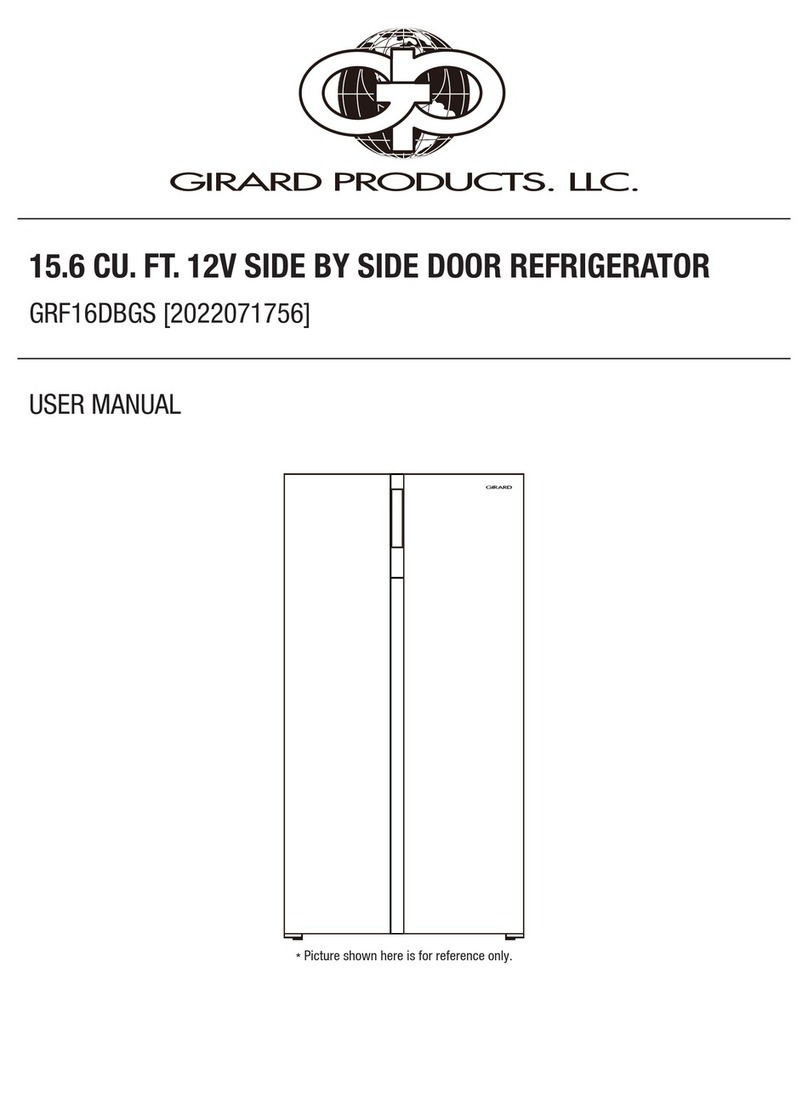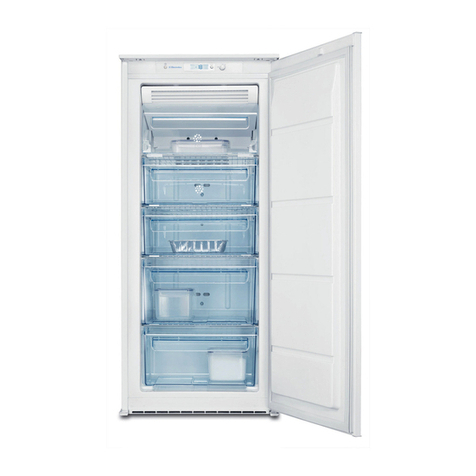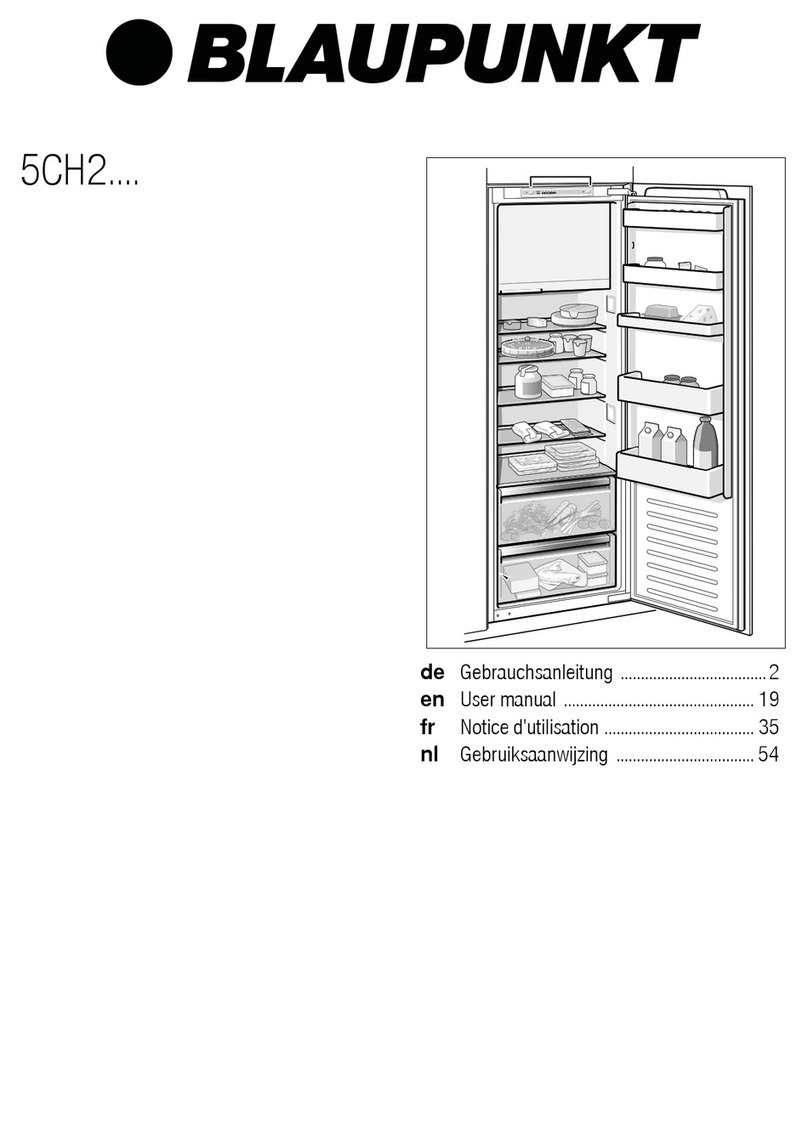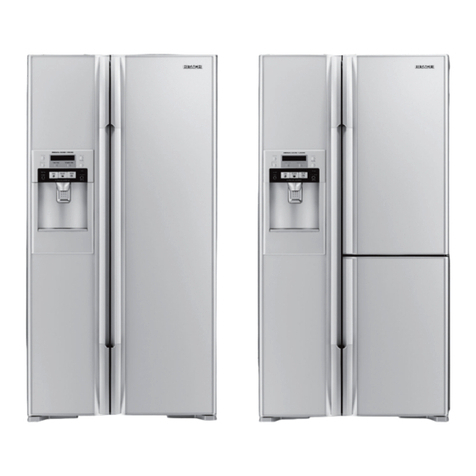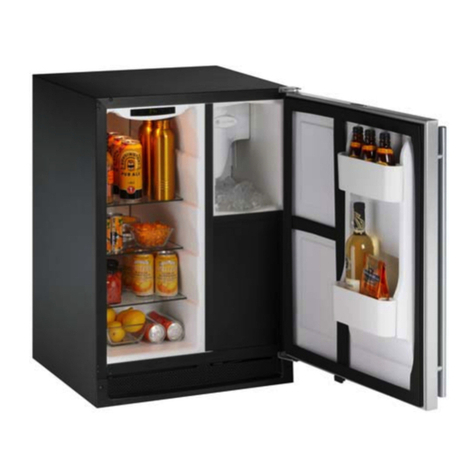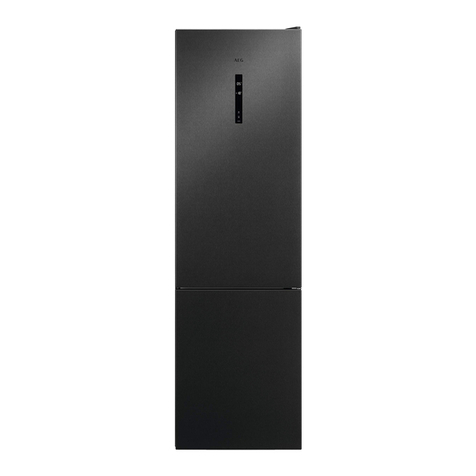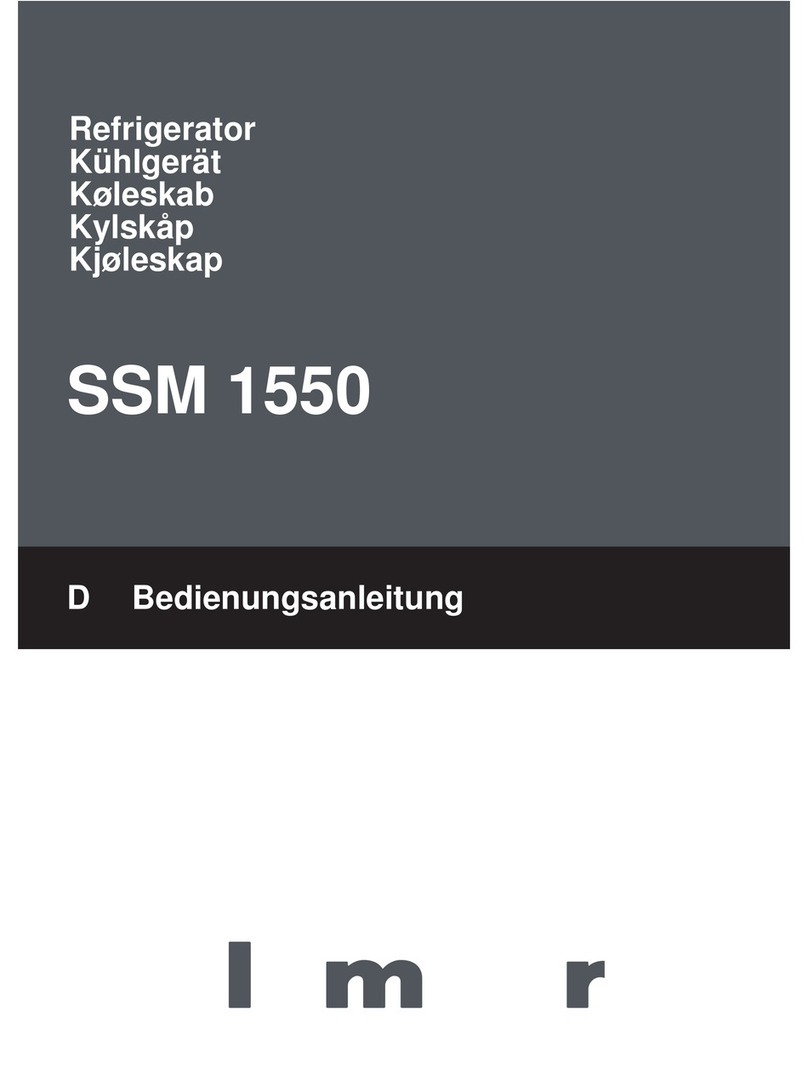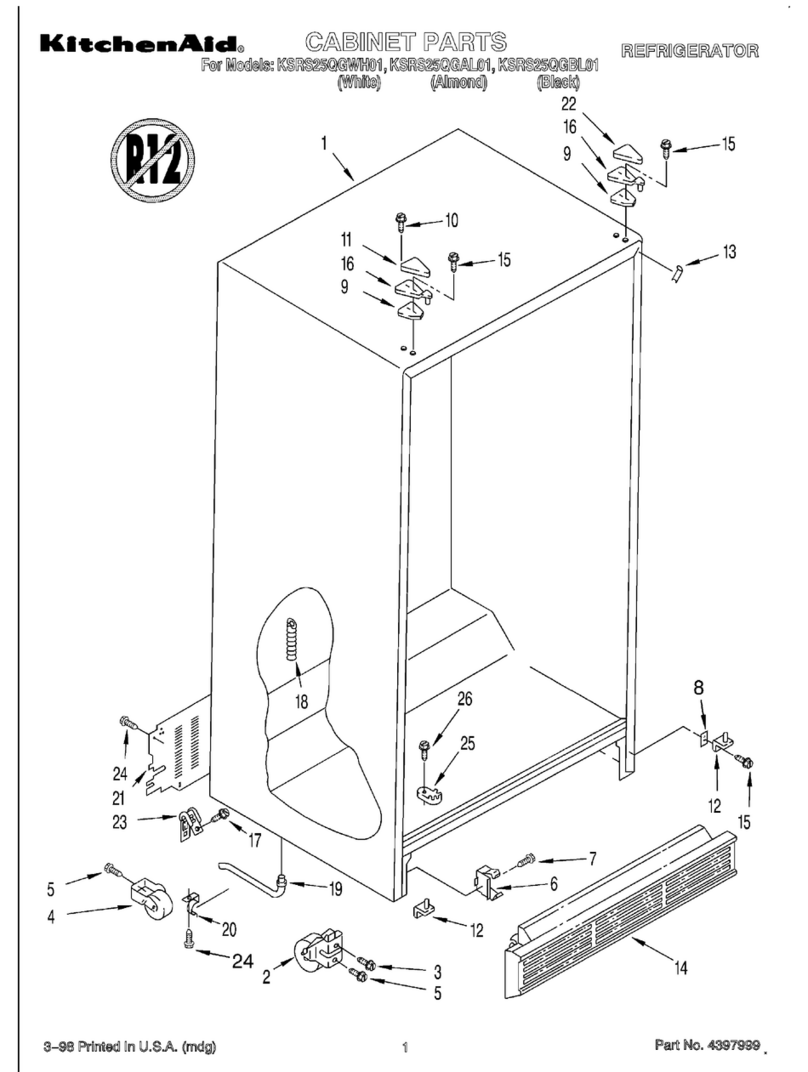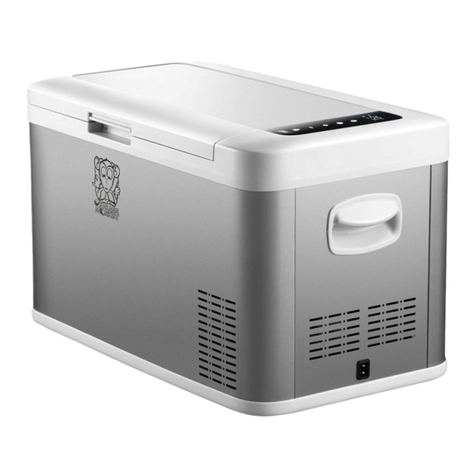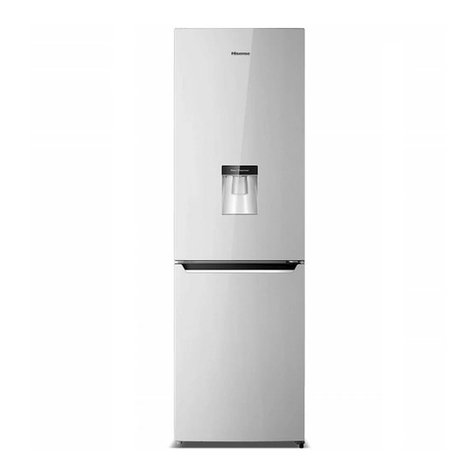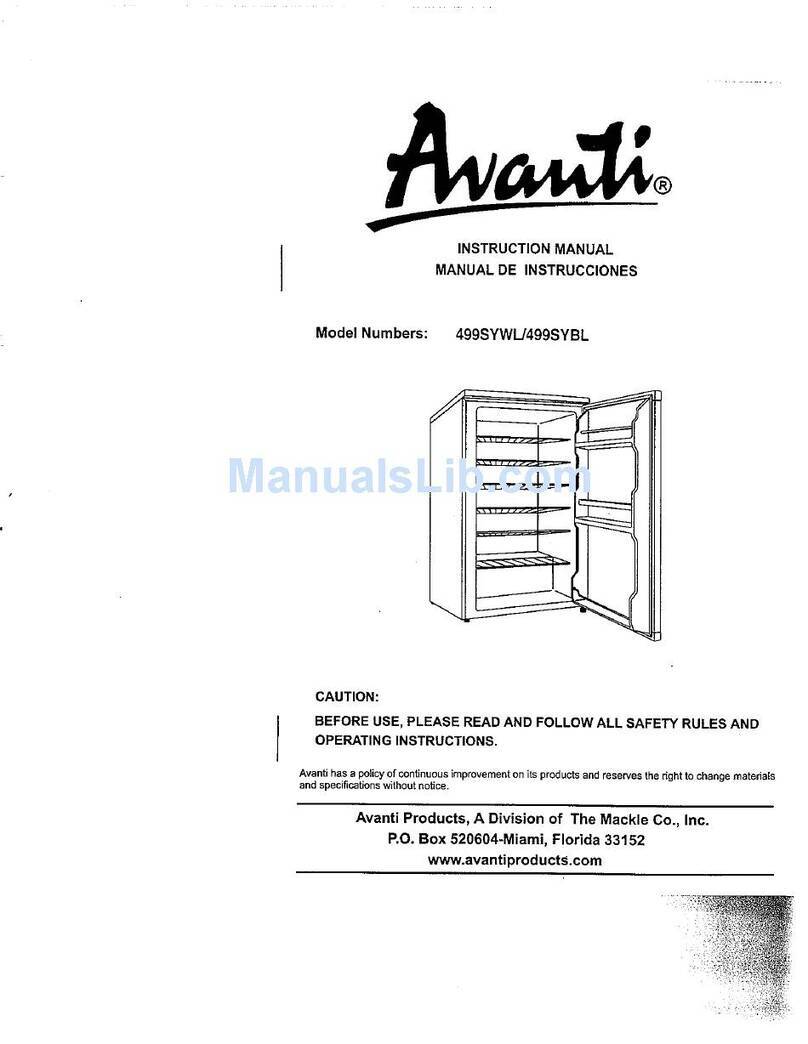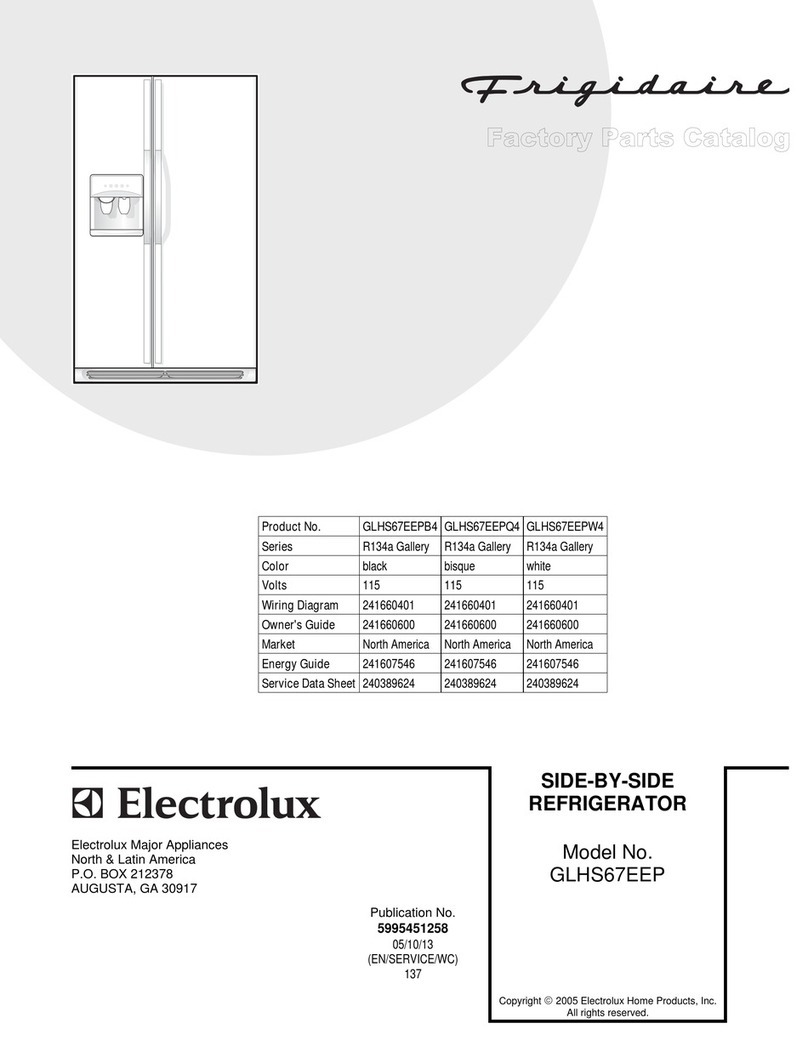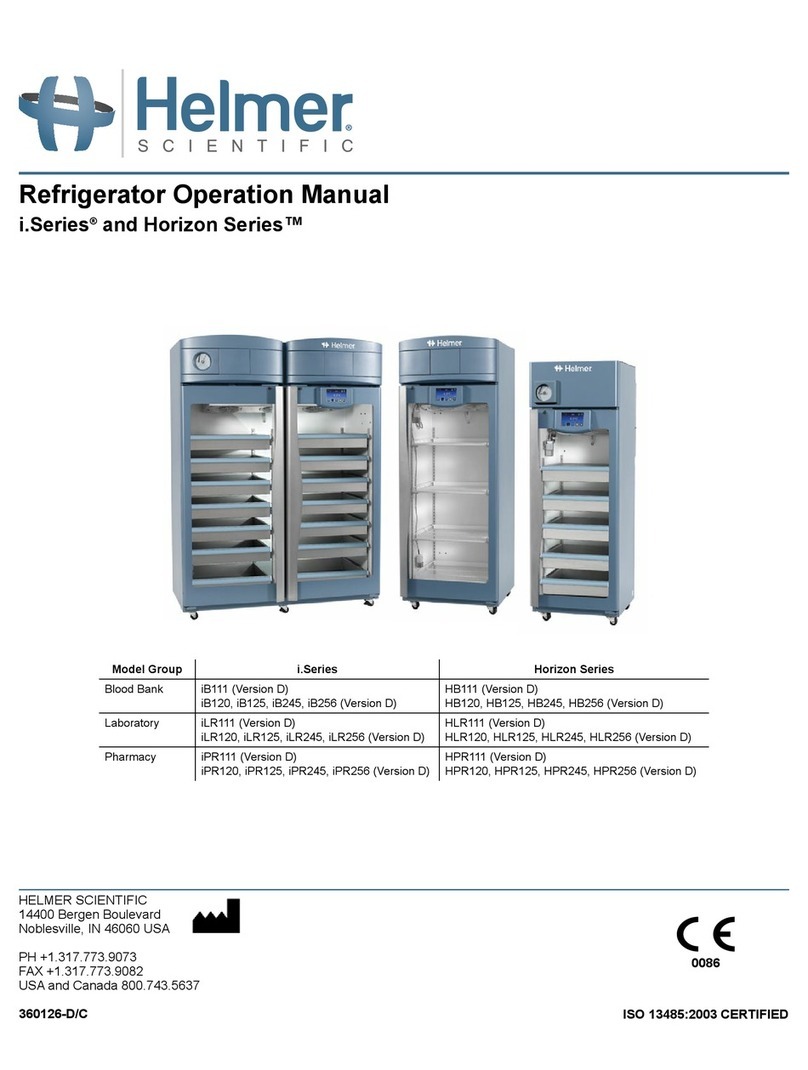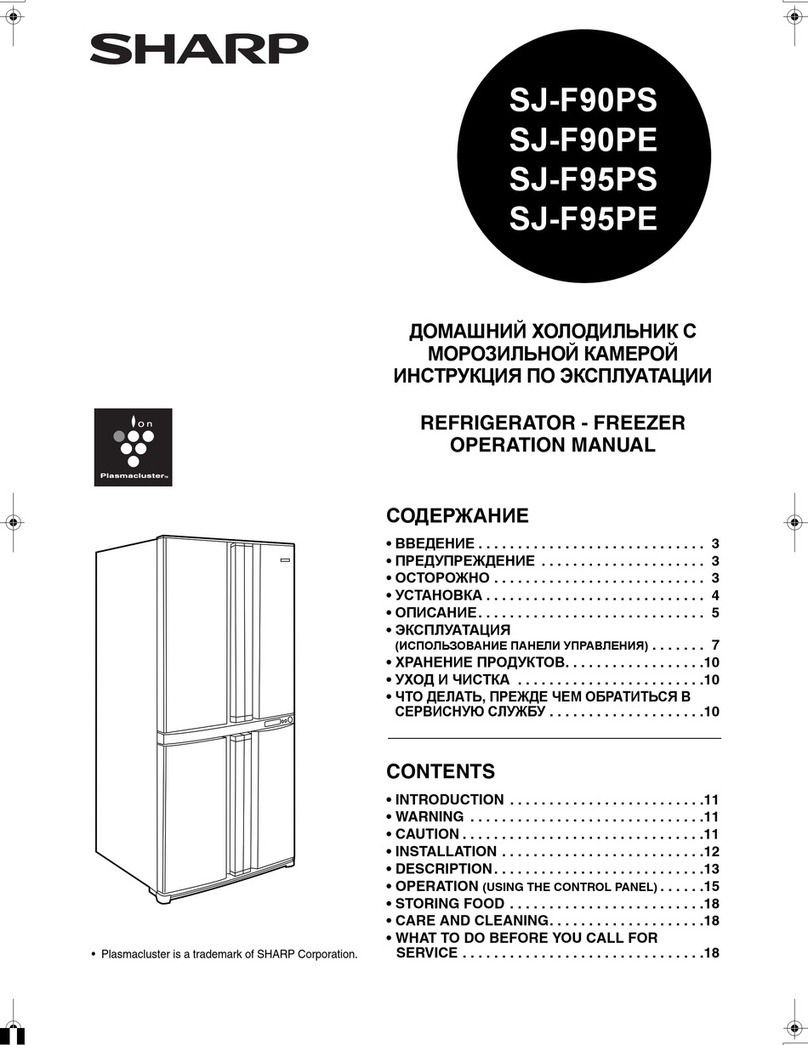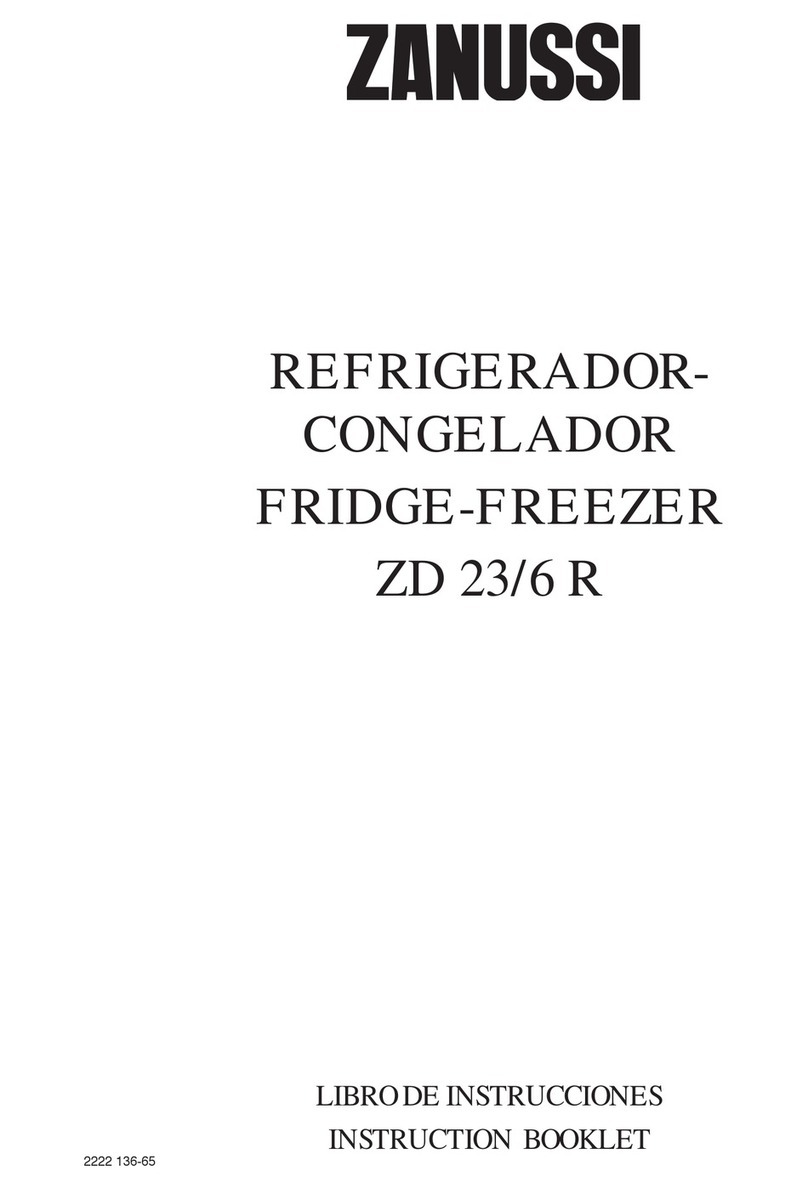Girard Products GRF10DBGL User manual

10 CU. FT. 12V BUILT-IN REFRIGERATOR
MODEL: GRF10DBGL, GRF10DBGR
LIPPERT NO.: 2022071754, 2022071755
USER MANUAL
*Picture shown here is for reference only.

CCD-0005837 Rev: 05-10-22 - 1 -
Thank you for purchasing this Girard product. Before operating your new appliance, please read these instructions carefully. This instruction manual
contains information for safe use, installation and maintenance of the appliance.
Please keep this instruction manual in a safe place for future reference. This will ensure safe use and reduce the risk of injury. Be sure to pass on this
manual to new owners of this appliance.
The manufacturer does not accept responsibility for any damages due to disregarding these instructions.
Table of Contents
Table of Contents..................................................................................................................................................................................................... 1
Explanation of Symbols ........................................................................................................................................................................................... 2
Important Safety Instructions .................................................................................................................................................................................. 2
General Safety Warnings..................................................................................................................................................................................... 2
Proper Disposal of the Refrigerator ..................................................................................................................................................................... 2
Parts and Features ................................................................................................................................................................................................. 3
Installation............................................................................................................................................................................................................... 4
What’s in the Box................................................................................................................................................................................................ 4
Site Preparation .................................................................................................................................................................................................. 4
Securing the Refrigerator.................................................................................................................................................................................... 5
Operation ................................................................................................................................................................................................................. 6
Temperature Control ........................................................................................................................................................................................... 6
Off Grid Usage .................................................................................................................................................................................................... 6
Extreme Temperature Usage ............................................................................................................................................................................... 7
Adjusting the Shelf (Optional) .............................................................................................................................................................................. 7
Storage Lock ...................................................................................................................................................................................................... 7
Transportation..................................................................................................................................................................................................... 8
Energy Saving Tips ............................................................................................................................................................................................. 8
Extended Storage................................................................................................................................................................................................ 8
Cleaning and Maintenance ...................................................................................................................................................................................... 8
Refrigerator Interior Cleaning .............................................................................................................................................................................. 8
Refrigerator Exterior Cleaning ............................................................................................................................................................................. 8
Battery Maintenance........................................................................................................................................................................................... 8
Replacing the Charcoal Filter............................................................................................................................................................................... 8
Circuit Diagram........................................................................................................................................................................................................ 9
Specifications.......................................................................................................................................................................................................... 9
Troubleshooting ....................................................................................................................................................................................................... 10

CCD-0005837 Rev: 05-10-22- 2 -
Explanation of Symbols
This manual has safety information and instructions to help you
eliminate or reduce the risk of accidents and injuries. Always respect all
safety warnings identified with these symbols. A signal word will identify
safety messages and property damage messages, and will indicate the
degree or level of hazard seriousness.
DANGER
Indicates an imminently hazardous situation which, if not avoided, will
result in death or serious injury.
WARNING
Indicates a potentially hazardous situation which, if not avoided, could
result in death or serious injury.
CAUTION
Indicates a potentially hazardous situation which, if not avoided, may
result in minor or moderate personal injury, or property damage.
Important Safety Instructions
General Safety Warnings
CAUTION
Improper installation, adjustment, alteration, service or maintenance
can cause personal injury or property damage. For assistance or
additional information, contact Girard customer service.
●Do not allow anything to touch the refrigerator cooling system.
●Make sure the electrical installation follows all applicable code.
●Do not bypass or change the refrigerator's electrical components or
features.
●Do not spray liquids near electrical outlets, connections, or the
refrigerator components. Most liquids are conductive, which can cause
electric shock, short circuit or fire.
●The refrigerator cooling system is under pressure. Do not try to repair or
to recharge a defective cooling system.
●The shelves have been fixed according to safety regulation. The shelves
must always be retained during operation and transportation. Contact
Girard customer service if the fixing mechanism is ever compromised.
●Make sure the glass door does not contact any hard object while
opening/closing the door.
●Do not slam the glass door.
WARNING
●The rear of the refrigerator has sharp edges and corners. To
prevent cuts or abrasions when working on the refrigerator, use
caution and wear personal protection such as cut resistant gloves,
and arm protection.
●Do not store or use gasoline or any flammable vapors and liquids
in the vicinity of this refrigerator.
●This appliance is not intended for use by persons (including
children) with reduced physical, sensory or mental capabilities, or
lack of experience and knowledge, unless they have been given
supervision or instruction concerning use of the appliance by a
person responsible for their safety.
●Children should be supervised to ensure that they do not play with
the appliance.
●To avoid an electrical shock hazard, relevant actions should be
performed by qualified and certified professionals. Power should
always be disconnected.
WARNING
●Keep ventilation openings, in the appliance enclosure or in the
built-in structure, clear of obstruction.
●Do not use mechanical devices or other means to accelerate
the defrosting process, other than those recommended by the
manufacturer.
●Do not use electrical appliances inside the food storage
compartments of the appliance, unless they are of the type
recommended by the manufacturer.
Proper Disposal of the Refrigerator
DANGER
Risk of child entrapment. To avoid the possibility of child entrapment,
please take the following precautions before you dispose of your
refrigerator.
●Remove all doors.
●Leave shelves in place so children may not easily climb inside.
●Never allow children to play with, operate, or crawl inside the
refrigerator.
Child entrapment and suffocation are not problems of the past.
Junked or abandoned refrigerators are still dangerous even if
they will sit for “just a few days.” If you are getting rid of your old
refrigerator, please follow the instructions below to help prevent
accidents.
Before you throw away your old refrigerator or freezer:
●Take off the doors.
●Leave the shelves in place so that children may not easily climb
inside.
Refrigerants
The refrigerant isobutane (R600a) is contained within the refrigerant
circuit of the refrigerator, a natural gas with a high level of environmental
compatibility, which is nevertheless flammable and under federal law
must be removed prior to product disposal. If you are getting rid of an
old refrigeration product, check with the company handling the disposal
about what to do.
Save these instructions for future reference!

CCD-0005837 Rev: 05-10-22 - 3 -
Parts and Features
1
2
3
4
5
6
7
8
9
10
11
12
13
10
Item Part Name
1Trim Kit
2Freezer Shelf
3Charcoal filter drawer
4Temperature Control
5Refrigerator Top Shelf
6Refrigerator Bottom Shelf
7Drawer
Item Part Name
8Air Vent
9½ Gallon Door Bin
10 Gasket
11 Refrigerator Door
12 Common Door Bin
13 Freezer Door

CCD-0005837 Rev: 05-10-22- 4 -
Installation
What’s in the Box
●Set the unit upright.
NOTE: The refrigerator may have been laid on its back for
transportation and delivery. This is acceptable, but must be stood
up-right vertically for at least 4 hours before running the compressor
to settle the compressor oil.
1. Unpack the unit, discard the packaging material appropriately.
2. Confirm everything is in the box. If anything is damaged or missing,
contact your dealer.
●Refrigerator x 1
●User Manual x 1
●Warranty Leaflet x 1
●Refrigerator Door Lock Cover x 1
●Storage Lock x 1
●Air Vent (on glass shelf) x 1
●Door Bin (on glass shelf) x 1
Site Preparation
Removing the Existing Refrigerator (if applicable)
WARNING
FIRE OR EXPLOSION
Gas leaks may occur in your system and result in a dangerous
situation. Always perform a leak test for possible leaks according to
the manufacturer’s instructions after removing any appliance.
●NEVER leak test when smoking. Never use a flame.
●Do not use any appliance until connection has been leak tested
and does not leak.
●Remove the existing refrigerator (if applicable):
−Unplug the 120V AC power cord from the receptacle at the rear
of the refrigerator enclosure.
−Disconnect the 12V DC leads from the refrigerator and cap the
lead ends.
−Turn off the LP gas supply to the refrigerator.
−Disconnect the LP gas line from the refrigerator. Cap the line
and verify there are no LP gas leaks.
−Remove the screws anchoring the refrigerator to the enclosure.
−Slide the refrigerator out from the enclosure and remove it from
the RV.
Select Location
●Your new refrigerator must stand on a flat surface which should
support a weight of 330Lbs (150kg). Surface must be level relative
to the coach floor plane.
NOTE: A slope that is comfortable to live with, and from normal
transportation is acceptable.
●If the appliance is to be placed onto the carpet, support it with a
wooden board. Do not place the appliance directly on the carpet, as
the heat from the compressor may cause the carpet to fade.
●For best and most efficient operation, the refrigerator should
operate within 50°F ~ 126°F (10°C ~ 52°C). If installing near large
heat sources, such as furnaces, fireplaces, furnaces, etc. Ensure
a thermal barrier, such as wood paneling isolates the refrigerator
space as not to hinder performance of the appliance.
Refrigerator Cabinet/Enclosure Preparation
●The built-in refrigerator is designed for 0" clearance to the sides,
top. There is an intentional ¼" clearance between the back of the
unit and cabinet to allow the service wire to enter the cabinet space.
Frame the cabinet to the dimensions indicated below:
H
D
W
¼” space wire entrance
to the cabinet
1/4"
W H D
23½"±¹⁄8" 527/8"±¹⁄8" 24"±¹⁄8"
●Squareness of the cabinet/enclosure needs to be within the "W" &
"H" dimensions described in two places on either end. The diagonal
measurement should be within ³⁄8" from each other.
●The base support of the cabinet/enclosure must be prepared with a
0 degree slope. If the existing cabinet/enclosure has a base with a
slope, shimming is required to level and support the refrigerator.
NOTE: Cabinet/enclosures of absorption style fridges may be
built with a 3 degree slope towards the rear. The slope is to allow
moisture drainage towards the sidewall vent.
●The cooling system is a forced air closed loop design, with inlet and
exhaust on the bottom front of the unit. The enclosure does not need
to be ventilated for any purpose. There is also no need for additional
insulation on sides and top of the enclosure. The enclosure can be
treated as a normal cabinet enclosure of the living space.
●Face surfaces of the cabinet enclosure made from solid MDF should
contain a softwood backing as a skeleton for mounting support, and
to reduce splitting.
NOTE: A softwood core with MDF laminate, or a soft/hardwood face
will be sufficient without a skeleton backing.
Electrical Connection
WARNING
Any electrical work required to install this appliance should be carried
out by a qualified or competent person.
All Girard products referenced in this manual are to be installed in
accordance with local and national codes, including the latest editions of
the following standards:

CCD-0005837 Rev: 05-10-22 - 5 -
USA:
●NFPA 1192
●NFPA 70
●ANSI/RVIA low Voltage
Canada:
●C22.1
●CSA Z240
The appliance is powered by Nominal DC 12V and must be supplied
at SAFETY EXTRA-LOW VOLTAGE circuit, a listed power converter that
conforms to UL 458 and/or C22.2 No. 107.1 is required.
Circuit Wiring Based on Voltage Drop:
Circuit wiring, gauge (AWG), length, and routing is to be determined by
the installer. It must not exceed a voltage drop at the appliance of more
than .4V DC.
To Measure: Start the appliance from warm, isolate and measure
the voltage difference between each DC12V power source(s) and the
appliance connection. If the Voltage drop exceeds .4V DC, the length of
wire should be shortened, and/or Wire gauge (AWG) increased.
Circuit Rating: Min 15Amp, Max 40Amp. Do not share circuit with any
other utilization equipment.
NOTE: The circuit must be fused appropriately for the wire gauge (AWG)
used, within 18" of the DC 12V power source.
Only a single blow fuse or manual resettable breaker is allowed, auto-
resetting breakers must not be used. Do not add an additional fuse to
the pigtail end of the appliance.
The following is a starting guideline for wire sizing and should be
adjusted based on actual voltage drop:
●Max 20ft = 10AWG
●Max 35ft = 8AWG
●Max 55ft = 6AWG
Installation TIPS:
●Voltage drop can be reduced by terminating the -12V (white) lead
directly to the vehicle chassis.
●-12V (white) and Ground (Green) leads can be combined at the
appliance or individually terminated.
Supply Wire
Pigtail Harness
from Refrigerator
Not Provided
●Enter supply wire into the cabinet space. It is acceptable to enter
through the cabinet floor, sidewall, backwall or ceiling. Ensure that
the wire enters within the free cabinet space behind the refrigerator.
●Girard recommends dropping the 12V supply wire from the upper
ceiling or upper rear wall. Temporarily affix the wires to the upper
half of the appliance with tape so that excess wire will droop
without risk of rubbing with the appliance chassis and floor during
installation.
Drainage Preparation
The cavity condensate drainage is captured in a drain pan integrated
with the unit. No external drainage needs to be prepared at this point.
Securing the Refrigerator
1. Center the appliance in the cabinet and adjust to align the trim
evenly to cover gaps. If the trim is uneven or protruding from the
cabinet face, ensure the cabinet base is level and add shims to align.
Do not force the appliance chassis into position as this will tweak it
out of shape.
2. Affix the refrigerator to the cabinet using the appropriate screws for
the material (Fig 1 & 2). Ensure that the screw affixes into a soft or
hardwood substrate for support. Mounting only into MDF material is
not sufficient.
NOTE: If securing a refrigerator in a cabinet with a sidewall vent, no
additional mounting or sealing is necessary on the rear of the appliance.
Fig. 1Fig. 1
Fig. 2Fig. 2
3. Install the air vent and tighten the screws. (Fig. 3)
Fig. 3Fig. 3

CCD-0005837 Rev: 05-10-22- 6 -
Operation
The appliance has a low-voltage shut-off function, intended to protect
your RV battery's from excessive drain.
NOTE: This function controls compressor operation only, a small electric
current is still used for the LED cavity light and low-voltage monitoring
system. Once voltage is increased, the system will automatically begin
normal operation.
The cavity LED light will also turn off after 3 minutes of the door being
open. The 3-minute timer can be reset by closing and re-opening the
door.
Temperature Control
CAUTION
Proper food storage temperatures is important to reduce the risk of
foodborne illness bacteria.
The temperature control knob is located in the fresh food compartment
of the refrigerator. It is designed to set the temperature from cold to
coldest or turn the refrigeration system off.
The recommended operating temperatures for proper food storage is as
follows:
Compartment Temperature
Fridge 36°F~40°F (2°C~4°C)
Freezer < 0°F (< -18°C)
Turn the thermostat to max when first starting the refrigerator and
after putting large quantities of food in. After a few hours turn it down
between mid and max position to reach the recommended operating
temperature setting. This will ensure the cabinet is thoroughly chilled
before food is placed into the refrigerator. Placing large amounts of food
may require additional cooling time to bring the temperature down.
Several conditions may require adjustment of the temperature dial, use
the following chart as a guideline.
Mid
Min Max
Thermostat
Setting
Fridge
Temperature
Freezer
Temperature
Max 30°F(-1.1°C) -11.2°F(-24°C)
Between Max and Mid 39.2°F(4°C) 1.4°F(-17°C)
Mid 43.7°F(6.5°C) 5°F(-15°C)
Between Mid and Min 45.5°F(7.5°C) 6.8°F(-14°C)
Min 46.4°F(8°C) 8.6°F(-13°C)
NOTE: The above chart is a guideline defined based on ideal
ambient conditions of 77°F (25°C). Several factors can alter the
performance, a refrigerator thermometer should be placed to achieve
maximum performance.
NOTE: If power is lost during operation, the refrigerator will automatically
resume operation after 3 to 5 minutes. The temperature knob does not
need to be adjusted or cycled to restart the refrigerator.
Off Grid Usage
●Where grid power is not available, the “OFF GRID” setting can be
used to maximize battery life.
●During travel, where a tow vehicle will provide constant battery
charging, it is recommended to operate the refrigerator at a normal
temperature setting dial (refer to “Temperature Control” section).
Once you have arrived and are dependent on your battery reserve,
rotate the knob to the “OFF GRID” setting of the dial.
●It is recommended to store meat and dairy products towards the
back and middle shelf of your refrigerator. Utilize the other space of
the refrigerator for beverages, condiments, and produce.
NOTE: Operation time of refrigerator in "OFF GRID" mode depends
on, but not limited to, factors such as; ambient temperature, battery
capacity, condition of battery, thermostat setting, food qty, and
frequency of door openings. Reference the below chart to adjust
operation time based on ambient temperature.
Ambient Temperature Operation Time
68°F(20°C) 100%
77°F(25°C) 80%
90°F(32.2°C) 55%
110°F(43°C) 25%

CCD-0005837 Rev: 05-10-22 - 7 -
Extreme Temperature Usage
The normal operating temperature for this appliance is 50°F (10°C) to
109.4°F (43°C).
The refrigerator can be used in ambient temperatures between 109.4°F
(43°C) and 125.6°F (52°C), but expect reduced cooling performance. If
the ambient temperature exceeds 125.6°F (52°C), allow the inside of
the coach to cool down before turning on. If the ambient temperature is
below 50°F (10°C), the dial control may need to be turned towards max
to operate the refrigerator. The freezer can be operated with ambient
temperatures below 32°F (0°C), but expect the refrigerator to be frozen.
Girard recommends increasing the ambient temperatures above 50°F
(10°C) for best results.
Adjusting the Shelf (Optional)
WARNING
To avoid the possibility of child entrapment, do not remove any shelf
from the refrigerator. Shelving is intended to deter children from play
in the compartment area.
The refrigerator and freezer shelves are fixed in the compartments
from the factory. Shelving adjustment is possible with the following
Instruction:
NOTE: The instructions will walk through the freezer compartment
shelving, but apply to all shelving.
To adjust the freezer compartment shelf position:
1. Open the compartment door. (Fig. 4)
Fig. 4Fig. 4
2. Lever the shelf fixing screw cover using a sharp tool.
(Fig. 5)
Fig. 5Fig. 5
Shelf FixingShelf Fixing
Screw CoverScrew Cover
3. Loosen the fixing screw using a Phillips screwdriver. (Fig. 6)
Fig. 6Fig. 6
4. Repeat steps 2 and 3 to loosen the shelf fixing screw on the other
side. Pull to remove the shelf out from its original position. (Fig. 7)
Fig. 7Fig. 7
5. Slide the shelf into an appropriate position and fix with screw. (Fig. 8)
Fig. 8Fig. 8
Repeat the process for shelving in the refrigerator.
Storage Lock
Utilize the Storage Lock, provided in the accessories package with the
unit, to prop the door open during extended storage. This will provide air
flow throughout to reduce moisture and odors.
NOTE: It is not recommended to leave the Storage Lock in position
during traveling, vibration may shake the latch loose.
1. Press the Storage Lock onto the lock bracket directly to install it.
2. Press both sides of the Storage Lock as per the arrows shown in Fig.
9 and pull to remove the Storage Lock.

CCD-0005837 Rev: 05-10-22- 8 -
Storage Lock
Lock Bracket
Fig. 9Fig. 9
3. Close the doors so that the door latch engages with the storage lock.
Transportation
Your refrigerator is designed to operate during normal transportation
of your coach. Please refer to the following guidelines to assist during
transportation.
●During long trips, leave your refrigerator off until 3 hours before
your destination arrival. This will help reduce any moisture/ice
accumulation and accidental battery discharging.
●Avoid traveling with food in the cavity. Wait until you have arrived to
your destination and remove any remaining food before departing.
●Never transport with the Storage lock in place.
●Turn refrigerator to "OFF" if climbing/crawling any off-road grades.
Compressor oil should resettle within 2 hours.
Energy Saving Tips
●When possible, place your coach or refrigeration in a position to
avoid direct sun.
●Cool down the hot food to normal temperature before putting them
into the refrigerator.
●Be sure to wrap foods properly, and wipe containers dry before
placing them in the refrigerator. This could prevent frost buildup
inside the refrigerator.
●Organize and label the food to reduce door openings and long time
searches.
Extended Storage
Any time the unit is not to be in-use, it is considered "extended storage".
Follow the below steps to properly prepare the unit for storage:
1. Remove all food and turn the dial to off.
2. Let any accumulated ice thaw, and dry out with a towel.
3. Disconnect power(either via main disconnect switch, and turning the
converter off or fuse).
4. Remove charcoal filter to preserve charcoal activation, replace with a
new filter every season or after three months of active use.
5. Install door Storage Lock.
See the "Storage Lock" section about how to install the Storage
Lock.
Cleaning and Maintenance
Refrigerator Interior Cleaning
It is recommended to clean the interior as needed due to spills and other
cleaning needs, or each time a new charcoal filter is replaced.
Refrigerator Exterior Cleaning
To maintain good appearance of your refrigerator, it is recommended to
clean it regularly.
Mix together one to two tablespoon of baking soda and one quart of
water. Wipe down the walls and glass doors of the refrigerator with
this solution, then rinse it with water. Wipe the refrigerator dry. Avoid
using abrasive cleaners and scrubbing pads or they will damage the
refrigerator surfaces.
Battery Maintenance
Your refrigerator has an automatic shut-off switch, should the voltage
drop below 9.6V at the terminal connection. This is to help prevent
permanent damage to your batteries.
NOTE: Once voltage is re-established the refrigerator will begin
working automatically per the setting of the dial.
When possible maintain the float voltage listed on your battery. Solar
is a good way to maintain battery voltage if a local power source is not
available.
Replacing the Charcoal Filter
Replace the charcoal filter by pulling it out from the refrigerator as
shown in Fig. 10 and replace with a new one.
Fig. 10Fig. 10

CCD-0005837 Rev: 05-10-22 - 9 -
Circuit Diagram
Red
GND
Green
To Chassis / 12V Ground
12V Power
10.2~14.2V DC
Inverter PCB
Blue
Black
Thermostat
Green
-
+
F+
F-
D
C
P
T
Fuse 15A
Compressor
Red
White
Red
Black Cooling
Fan
M
M
White
Compartment
Light (LED)
Timer
3 min.
Door
Switch
Specifications
H
D
W
Capacity (cu. ft.) 10 cu. ft.
Product Dimensions (W x H x D) 24¼ x 60¹⁄8x 25¾” (616 x 1528 x 655mm)
Recessed Dimensions (W x H x D) 23¼ x 525/8x 23¾” (592 x 1338 x 604mm)
Net Weight (lbs/kg) GRF10DBGL
GRF10DBGR 139lbs / 63kg
Rated Power Supply Voltage DC 12V (Min. 9.6V to max. 17V)
Rated Current 11A @ start-up & maximum cooling setting
Temperature Range Refrigerator Compartment: +32°F ~ +50°F (0°C ~ 10°C)
Freezer Compartment: -4°F ~ +10.4°F (-20°C ~ -12°C)
Typical Runtime (Off Grid Usage,
powered by 100amp/hr battery)
49 hours @ 77°F (25°C)
31 hours @ 90°F (32.2°C)

CCD-0005837 Rev: 05-10-22- 10 -
Troubleshooting
A qualified professional is required for any servicing of the compressor drive board and the control board, otherwise it will void the product warranty.
If you encounter a problem similar to what is mentioned in the following table, try the suggested solution below to see if you can solve the problem
before calling service.
Problem Solution
Refrigerator does not work
The circuit breaker tripped or fuse blown.
The unit temperature control dial is set to the “OFF” position.
Battery voltage might be out of operating range. Check battery voltage for 10.5V under load.
Compressor turns on and off
frequently
The room temperature might be elevated.
The door is open or is frequently opened.
The temperature control dial is not set correctly.
The door gasket is torn or not sealing properly.
Battery voltage might be low, and dropping out of operating range. Check battery voltage for 10.5V
under load.
Refrigerator compartments are too
warm
Temperature control dial is not set correctly (see the "Temperature Control" section for
instructions on setting the temperature).
The door is open or is frequently opened.
The door gasket is torn or not sealing properly.
A large amount of warm or hot food was stored recently. Wait for the refrigerator to reach its
selected temperature.
The refrigerator has recently been disconnected for a period of time.
Vibrating or rattling (slight vibration
is normal)
The refrigerator is placed on uneven or weak surface.
Temperature setting, such as max position, may affect the vibration level. Refer to the
"Temperature Control" section.
Moisture or ice inside the
refrigerator
The door is open or is frequently opened.
Temperature control dial is set at too cold of a position
Moisture forms on the outside of
refrigerator This is normal in hot and humid weather.
Bubbling or gurgling sounds (like
boiling water) This is the normal sound of refrigerant (used to cool refrigerator) circulating throughout the system.
Popping or cracking sounds when
compressor comes on This is normal for metal parts to undergo expansion and contraction, like hot water pipes.
The door can't be closed properly
The refrigerator is not on a level surface.
The door was reversed and not properly installed.
The gasket is dirty or bent.
The storage basket, shelves, and bins are not seated properly.

Girard Products LLC.
●1361 Calle Avanzado, San Clemente, CA 92673
●Toll Free: 1-574-537-8900 ●Email: customerser[email protected]
www.greenrvproducts.com
IM-FHA00120 V1.0
This manual suits for next models
3
Table of contents
Other Girard Products Refrigerator manuals
